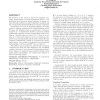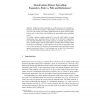69 search results - page 8 / 14 » The cover time of sparse random graphs |
ASPDAC
2010
ACM
14 years 8 months ago
2010
ACM
Level-sensitive transparent latches are widely used in high-performance sequential circuit designs. Under process variations, the timing of a transparently latched circuit will ada...
CORR
2012
Springer
13 years 5 months ago
2012
Springer
Graphs are fundamental data structures and have been employed for centuries to model real-world systems and phenomena. Random walk with restart (RWR) provides a good proximity sco...
207
click to vote
COMPGEOM
2011
ACM
14 years 1 months ago
2011
ACM
We introduce a new notion of minors for simplicial complexes (hypergraphs), so-called homological minors. Our motivation is to propose a general approach to attack certain extrema...
ICALP
2009
Springer
15 years 4 months ago
2009
Springer
Abstract Randomized rumor spreading is an efficient protocol to distribute information in networks. Recently, a quasirandom version has been proposed and proven to work equally we...
106
click to vote
ICALP
2007
Springer
15 years 4 months ago
2007
Springer
Abstract. We deal with two intimately related subjects: quasi-randomness and regular partitions. The purpose of the concept of quasi-randomness is to measure how much a given graph...


